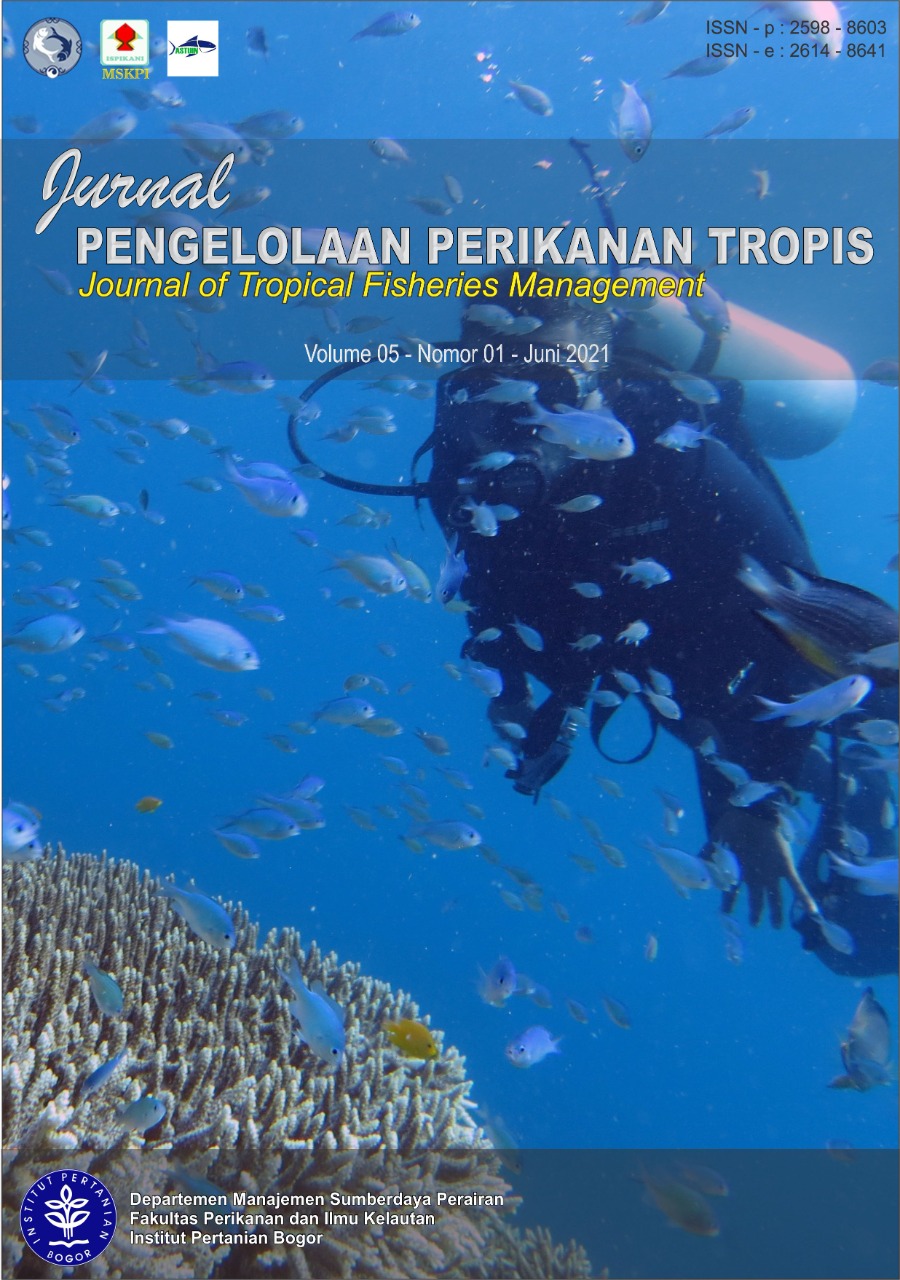Density and ecological index of nudibranch in Humbolt Bay Water Jayapura City, Papua Province, Indonesia
Indeks keanekaragaman, keseragaman, dan dominasi nudibranch di perairan Teluk Humbolt, Kota Jayapura, Papua, Indonesia
Abstract
Nudibranchs are marine invertebrates from the mollusc phylum of the gastropod class subclass Opisthobranchiata. Nudribanch has many benefits because of its compound content, has the beauty of attractive colors as an underwater tourism photo object, and can be used as biota indicators of ecosystem health. The purpose of this research is to assess density, diversity index, Evenness index, and dominance index as well as water parameters that support the growth and development of nudibranchs in Humbolt Bay, Jayapura City. The research method used is the Underwater Visual Census (UVC) method at a depth of 5 m and 10 m with an observation width of 2.5 to the right and to the left along 100 m. The results showed that there were 14 types of nudibranchia with 122 individuals, with the dominant species being Phyllidiella pustulosa and Phyllidia varicosa. The density of the nudibranch is quite low, which is around 0.022-0.036 individuals / m2, the Diversity Index is low, which is around 1.228-1.463, the Uniformity Index is classified as a small population, 0.120-0.260 (close to 0), and the Dominance Index is quite stable, namely 0.270-0.402. Based on water parameter data It was found that the waters and habitats in Jayapura City's Humbolt Bay are under pressure as indicated by the decline in the quality of the ecosystem, but are still in normal conditions that support the growth and development of marine life, especially nudibranchs.
Downloads
References
Aiken RB. 2003. Some aspects of the life history of an intertidal population of the Nudibranch Dendronotus frondosus (Ascanius, 1774) (Opisthobranchia: Dendronotoidea) in the bay of fundy. Veliger. 46(2): 169-175. Arbi UY. 2012. Aspek biologi dan sistematika nudibranch. Fauna Indonesia. 10(1):22-29.
Behrens DW. 2005. Nudibranch bihavior. New Publications, Inc. Jacksonville, FL. 176 pp.Boyd CE. 1988. Water Quality in Warmawater Fish Ponds. FourthPrinting. Auburn University Agriculture Experiment Station. Alabama. USA. 359p.
Cyrne R, Rosa IC, Faleiro F, Dionísio G, Baptista M, Couto A, Pola M,Rosa R. 2018. Nudibranchs outofwater: long-term temporal variations intheabundance oftwo Dendrodorisspecies underemersion. Helgol Mar Res 72:14
Daly AJ, Baetens JM, De Baets B. 2018. Ecological diversity: measuring the unmeasurable. Mathematics.6:119. Dayrat B. 2006. A Taxonomic revision of paradoris sea slugs (Mollusca: Gastropoda: Nudibranchia: Doridina). Zoological Journal of the Linnaean Society. 147(2): 125-238.
Debelius H. 2004. Nudibranch and Sea Snails Indo-Pacific Field Guide. Frankfurt. IKAN-Unterwasserarchiv.320p.
Dionisio G, Rosa R, Leal MC, Cruz S, Brandao C, Calado G, Serodio J, Calado R. 2013. Beauties and beasts: a portrait of sea slugsaquaculture. Aquaculture. 408:1–14.
Effendi H. 2003. Telaah Kualitas Air bagi Pengelolaan Sumberdaya dan Lingkungan Perairan. Penerbit Kanisius. 258p.
English S, Wilkinson C, Baker V. 1997. Survey Manual For Tropical Marine Resources(2ndEdition). Townsville. ASEAN –Australia Marine Science Project Living Coastal Resources. Australia. 390p.
Fisch K, Hertzer C, Bohringer N, Wuisan ZG, Schillo D, Bara R, Kaligis F, Wagele H, Konirg GM, Schaberle T. 2017. The potential heterobranche found around Bunaken Island for the production of bioactive compounds. Marine drugs.15: 1-45.
Grande C, Templado J, Cervera JL,Zardoya R. 2004. Phylogenetic Relationships Among Opistobranchia (Mollusca: Gastropoda) Based on Mitochondrial cos 1, trnv, and rrnl Genes. Molecular Phylogenetics and Evolution. 33: 378-388.
Karuso P, Scheuer PJ. 2002. Natural products from three nudibranchias: nembrotha kubaryana, hypselodoris infucata and chromodoris petechialis. Molecules.7:1-6.
Krebs CJ. 1994. Ecology The Eksperimental Analysis of Distribution and Abudance. Third edition. New York:Haeper and Row Publisher. 672p.
Magurran AE. 1988. Ecological Diversity and Its Measurement.New Jersey: Princeton University Press. 192p
Odum EP. 1996. Dasar-dasar ekologi: Terjemahan dari Fundamental of Ecology. Alih Bahasa T Samingan, Edisi ketiga. Yogyakarta: Gadjah Mada University Press. 697p.
Pidwirny MJ. 2000. Fundamentals of Physical Geography. http://www.geog.ouc.bc.ca/physgeog/physgeoglos/i.
Sari LN, Aunurohim. 2013. Korelasi komunitas nudibranchia dengan komunitas porifera di perairan Pasir Putih, Situbondo. Jurnal Sains dan Seni Pomits.2(2): 2337-3520.
Setyobudiandi I. 1997. Makrozoobentos. Bogor: Institut Pertanian Bogor.
Wagele H, Klussmann-Kolb A. 2005. Opistobranchia (Mollusca: Gastropoda)–more than just slimy slugs. shell reduction and its implications on defence and foraging. Frontiers in Zoology. 2(3): 1-18.
Wagele H, Klussmann-Kolb A, Verbeek A, Schrodl M. 2013. Flashback and foreshadowing a review of the taxon Opisthobranchia. Organisms, Diversity and Evolution.14:133–149.
Copyright (c) 2021 Jurnal Pengelolaan Perikanan Tropis (Journal of Tropical Fisheries Management)

This work is licensed under a Creative Commons Attribution 4.0 International License.
After the article is submitted and published in this journal, it is fully copyrighted by the Journal of Tropical Fisheries Management. If excerpts from other copyrighted works are included, authors must obtain written permission from the copyright owner and give credit to the source in the article. Then, authors or reader is allowed to copy, share, and redistribute articles/material in any form. But it must still include the appropriate source and credit because the article in this journal is licensed by Creative Commons Attribution 4.0 International License (CC BY 4.0).



1.png)
1.png)








